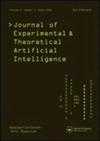基于蜂窝式自动机的无线传感器网络安全数据传输优化路由
IF 1.7
4区 计算机科学
Q3 COMPUTER SCIENCE, ARTIFICIAL INTELLIGENCE
Journal of Experimental & Theoretical Artificial Intelligence
Pub Date : 2021-02-10
DOI:10.1080/0952813X.2021.1882002
引用次数: 10
摘要
传感器节点包括通过测量温度、压力和湿度等因素来控制和监测环境的能力。保证网络中的安全路由是无线传感器网络(WSN)中的一项重要而重要的任务。尽管网络中采用了各种路由协议,但提供安全性和维护能量仍然是研究界的一个具有挑战性的问题。因此,本研究提出了一种有效的基于粒子的蜘蛛猴优化算法(P-SMO)来选择最优路由来管理WSNs中的安全通信。据此,对网络进行仿真,并基于基于高效学习自动机的单元聚类算法(ELACCA)选择簇头,并根据选择的簇头建立路由路径。因此,提出的P-SMO算法基于能量、延迟、一致性因子和信任等因素建立安全路由路径。提出的P-SMO算法是粒子群算法(PSO)和蜘蛛猴算法(SMO)的结合,可以有效地定义最优路径。通过对该路由协议的分析,证明了该路由协议的有效性能,其最大存活节点数、最大覆盖范围、最大能量平衡指数和最大平均剩余能量分别为67、93.407%、0.7555和0.3402 J。本文章由计算机程序翻译,如有差异,请以英文原文为准。
Cellular automata-based optimised routing for secure data transmission in wireless sensor networks
ABSTRACT Sensor nodes encompass the capability of controlling and monitoring the environment by measuring the factors, like temperature, pressure, and humidity. Ensuring secure routing in the network is an important and significant task in the wireless sensor network (WSN). Even though various routing protocols are adopted in the network, providing security and maintaining the energy is still a challenging issue in the research community. Thus, an effective particle-based spider monkey optimisation (P-SMO) algorithm is proposed in this research to select the optimal route to manage secure communication in WSNs. Accordingly, the network is simulated and the cluster heads (CHs) are chosen based on the efficient learning automata-based cell clustering algorithm (ELACCA) such that the routing path is established based on the chosen CHs. Thus, the proposed P-SMO algorithm establishes the secure routing path based on the factors, such as energy, delay, consistency factor, and trust. The proposed P-SMO algorithm is the integration of particle swarm optimisation (PSO) and spider monkey optimisation (SMO) algorithm in such a way that the optimal routes are defined effectively. The analysis of the proposed routing protocol proved the effective performance with the maximal number of nodes alive, coverage, energy balancing index, and the average remaining energy of 67, 93.407%, 0.7555, and 0.3402 J, respectively.
求助全文
通过发布文献求助,成功后即可免费获取论文全文。
去求助
来源期刊
CiteScore
6.10
自引率
4.50%
发文量
89
审稿时长
>12 weeks
期刊介绍:
Journal of Experimental & Theoretical Artificial Intelligence (JETAI) is a world leading journal dedicated to publishing high quality, rigorously reviewed, original papers in artificial intelligence (AI) research.
The journal features work in all subfields of AI research and accepts both theoretical and applied research. Topics covered include, but are not limited to, the following:
• cognitive science
• games
• learning
• knowledge representation
• memory and neural system modelling
• perception
• problem-solving

 求助内容:
求助内容: 应助结果提醒方式:
应助结果提醒方式:


